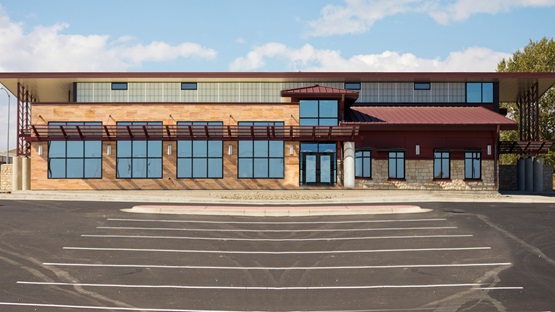Thanks to new updates and enhancements, a data-mapping tool from our Center for Indian Country Development (CICD) team now offers policymakers and others more thorough information on access to credit in Indian Country. The Mapping Native American Financial Institutions tool provides locations and data profiles of financial entities that serve Native communities in the United States and foster financial inclusion in Indian Country.
NAFIs are distinguished by their public commitments to provide affordable and culturally informed financial services, credit, and capital in Indian Country, where obtaining a loan to start a business or buy a home can be daunting and at times impossible. For many reasons, Native entrepreneurs frequently lack access to the credit and capital that are relatively straightforward for others to obtain. Banks have a history of discriminatory practices with respect to Native communities. Much of the land in Indian Country is held in trust by the federal government, and trust land cannot be used as collateral to secure loans. Lending institutions may be uncertain about the particulars of tribal governments, regulations, and courts. Native people may lack credit histories and be unfamiliar with financing mechanisms. And in some Native communities, residents face a dearth of readily accessible banks and branches.
In the last two decades, NAFIs have begun to significantly address the gap in access to credit in Indian Country. In 2018, CICD created its mapping tool to help policymakers and those in the banking industry understand the importance and growing impact of NAFIs. The tool can also be used by Native entrepreneurs and home buyers as a guide to NAFIs’ locations and lending portfolios. CICD recently refreshed the map tool to include up-to-date geographic-distribution information and new data on loan funds, technical assistance grants, and financial assistance awards. These new data help provide a more complete picture of lending activities undertaken by the three categories of NAFIs, which we discuss below.
NAFI types
NAFIs all work to address the unique socioeconomic and financing needs of Indian Country. They exist to help grow local economies, provide financing for affordable housing, and support Native-owned enterprises. They offer creative solutions to address credit gaps in Native communities. They provide financial products and services, along with training and technical assistance, to Native residents who experience challenges accessing credit.
We define NAFIs according to their designations as Native Community Development Financial Institutions (CDFIs) or Native Minority Depository Institutions (MDIs). A CDFI is a specialized entity that provides financial products and services in markets not fully served by traditional financial institutions. The CDFI Fund, a division of the U.S. Department of the Treasury, certifies and provides financial and technical assistance to CDFIs. Native CDFIs are those with at least 50 percent of their activities serving Native American, Alaska Native, and/or Native Hawaiian people or communities. An MDI—according to the most frequently applied definition, which is specific to banks and is set by the Federal Deposit Insurance Corporation (FDIC)—is a federally insured depository institution for which (1) 51 percent or more of the voting stock is owned by minority individuals; or (2) a majority of the board of directors is minority and the community that the institution serves is predominantly minority. Thus, Native MDIs are those with Native ownership or a majority of the bank’s board identifying as Native.
We group NAFIs into three broad categories: Native banks, Native credit unions, and Native loan funds. Some of these institutions are owned and operated by tribal governments, while others are privately owned and operated. All of these institutions understand the need for lending in Indian Country and the challenges that exist for Native entrepreneurs.
Native banks
Native banks are banks that are Native CDFIs, Native MDIs, or both. Native banks are committed to working in tribal settings, managing risk through an understanding of the ways that collateral, loan guarantees, credit profiles, and tribal laws and regulations differ from the non-tribal setting. They provide Native community members with a mix of mainstream financial access and culturally appropriate banking services. These might include financial workshops and consumer products that incorporate cultural values and community-specific characteristics. Native banks also have a deep understanding of trust lands and tribal court systems, which helps them serve Native customers in distinct ways.
For example, on its website, Bay Bank in Green Bay, Wisconsin, states: “Bay Bank is the only Greater Green Bay bank to offer the U.S. Department of Housing and Urban Development Section 184 Indian Home Loan Guarantee Program.” The offering is critical for meeting the needs of Native communities, because the Section 184 program is designed to facilitate home building, buying, or rehabbing on Indian lands and Hawaiian home lands, including trust land. Bay Bank is owned by the Oneida Nation and has assets of nearly $200 million and a team of 32 employees. According to Bay Bank’s website, the bank has facilitated over $80 million in Section 184 loans since 2005.
Some 1,300 miles to the west, the $100-million-asset Eagle Bank in Polson, Montana, is committed to promoting financial inclusion. “We take our mandate to help the underbanked and unbanked seriously,” said Andrew West, president and CEO. Eagle Bank is owned by the Confederated Salish and Kootenai Tribes on behalf of their 8,000 members. Its customers include both Native and non-Native people living and working on and around the 1.3-million-acre reservation in western Montana.
CICD’s mapping tool currently shows 20 Native banks, all of which the FDIC includes on its second quarter 2022 list of MDIs and three of which also have a Native CDFI designation.1 According to the FDIC Quarterly Banking Profile, from which all of the Native-bank-related data for the map tool are extracted, Native banks reported combined total assets of about $7.7 billion as of the second quarter 2022 time period. Although the total is only a tiny portion—0.03 percent—of the $24 trillion in total assets of banks in the United States,2 Native banks are notable for delivering material amounts of financing to under-capitalized communities. According to an analysis we conducted of Quarterly Banking Profile data, Native banks’ median equity capital was over $26 million in second quarter 2022 and their median value of net loans and leases was over $145 million.3 Interestingly, 10 Native banks on the FDIC’s list of MDIs are headquartered in the state of Oklahoma, and they reported combined assets of well over $5 billion.
Native credit unions
Native credit unions are credit unions that are Native CDFIs, Native MDIs, or both. Credit unions use a separate definition of “MDI,” as set by the National Credit Union Administration (NCUA): an MDI is a federally insured credit union in which a majority of its current members, its board of directors, and the community it services, as designated in its charter, fall within any of the following eligible minority groups: any Asian American, Black American, Hispanic American, or Native American.
As with any type of credit union, Native credit unions have a community-focused governance mission that provides them with enough flexibility to offer products and services suited to their customers—in this case, Native communities, where there are higher proportions of low-income and underserved populations than in non-Native communities. Services Native credit unions offer include checking accounts, credit-builder loans, vehicle loans, technical assistance for business owners, and financial education.
For example, Lakota Federal Credit Union, located on the Pine Ridge Reservation in South Dakota, sets itself apart from other financial institutions by making membership as accessible as possible. “We’re enabling Pine Ridge and Rosebud reservation residents who are low-income to open and maintain an account without having minimum levels of deposits or balances beyond an initial five dollars,” said Tawney Brunsch, a board member. Lakota Federal Credit Union ensures that its members understand the role the organization plays in providing a path to financial well-being. “Having a focus on education and technical support during the membership process allows our members to make healthier financial decisions and reach better financial positions in life, which then spreads to the next generation,” Brunsch said.
CICD’s mapping tool currently shows 11 Native credit unions, all but one of which are included in a list the NCUA maintains of credit unions that meet its definition of MDIs serving Native Americans. According to our analysis of Native credit unions’ quarterly call reports, which is based on data that are included in the mapping tool, these institutions reported combined assets of over $600 million. The median value of total net worth was over $3 million and the value of total loans was over $5 million.
Native loan funds
Native loan funds are Native CDFIs that are structured as loan funds. That is, they are mission-driven, non-depository institutions. These entities may focus on community development, housing, or small business. They offer a mix of products and services such as consumer loans; loans for micro- and small businesses, housing, and community facilities; commercial real estate products; financial education; credit and homeownership counseling; and business and real estate technical assistance.
CICD’s mapping tool, which pulls its Native loan fund data from the CDFI Fund and the Internal Revenue Service’s Annual Extract of Tax-Exempt Organization Financial Data, shows 51 Native loan funds in the United States. These entities must obtain capital to pay for the loans and training they provide to clients, along with the salaries and operations that help underwrite and service the loans. Native loan funds’ specialization lies in their ability to find and blend various forms of capital. The CDFI Fund, through its Native American CDFI Assistance Program, remains their key capital source. Native loan funds report a need for additional sources of capital to cover the entire cost of lending operations. According to our analysis of recent IRS Form 990 extracts that are available for 40 of the 51 Native loan funds and are reflected in the CICD’s mapping tool, reported combined total assets were over $325 million for the most recent tax year. Median net assets were about $3 million. In addition, the median loan portfolio size for Native loan funds was about $1.3 million.
Evidence shows that Native loan funds can increase credit performance and credit access of Native residents. Loan fund staff “utilize their depth of knowledge of tribal clients and communities to deliver services, programs, and lending capital to fit their unique needs,” said Charlene Virgilio, executive director of Four Directions, a Native loan fund located in Maine. Her organization has deployed almost $20 million in Indian Country in Maine, which included making 231 home loans for Wabanaki families and 39 small business loans totaling $4 million, and creating 86 units of affordable housing.
Looking ahead
CICD’s NAFI map tool enables Native economic development stakeholders to search for information on financial entities by headquarters name or location, institution type, and CDFI designation. A user can leverage the map’s data to learn about a particular NAFI, its assets, and loan portfolio sizes; and identify opportunities for cross-collaboration in communities nationwide. Policymakers can use the tool to assess the financial status of NAFIs as measured through time, as well as their geographic distribution and accessibility. Native entrepreneurs and homeowners who are seeking financial products and services can use the tool to learn about and compare NAFIs.
The CICD NAFI map is updated every year. When it was released in 2018, the map did not include any financial data on loan funds nor any information on CDFI Fund awards that NAFIs received. In addition to the yearly financial information on assets, loan portfolio sizes, and year-end surpluses or deficits that the map has shown since 2018, the 2022 map update shows total technical assistance grants and financial assistance awards from the CDFI Fund’s Native Initiatives program. These award data go back three years and are extracts from the CDFI Fund’s Searchable Award Database.
What trends does the NAFI map show so far? Because some of the data categories on the map are newly added as of 2022, drawing direct comparisons between conditions in 2018, when the map debuted, and all current conditions in 2022 isn’t possible. But a simple count of institution types shows some movement in the NAFI sector over the last four years. The 2018 map featured 18 Native banks, 15 Native credit unions, and 61 Native loan funds, whereas the current map lists 20 Native banks, 11 Native credit unions, and 51 Native loan funds. Some institutions listed in 2018 have ceased to exist, while others lost or gained their NAFI categorization. For example, between 2018 and 2022, 13 Native loan funds lost their CDFI certification and, thus, their NAFI categorization. One ceased operation and four joined the NAFI list. As we add more data to the mapping tool in the future, we’ll be able to assess industry growth, generate conversations around efforts to preserve NAFIs’ CDFI and MDI designations, and gain a clearer understanding of where Native communities’ financial needs are or aren’t being met.
Endnotes
1 There are two bank holding companies—that is, companies that own banks—that are themselves Native CDFIs and that own Native-CDFI-recognized banks. In these cases, the banks are shown on the map rather than the holding companies.
2 According to the FDIC Quarterly Banking Profile, a total of 4,771 FDIC-insured commercial banks and savings institutions reported combined total assets of $24 trillion as of the second quarter of 2022.
3 From a Federal Reserve Bank of Minneapolis analysis of financial institutions’ quarterly call reports.
Michou Kokodoko is a project director in the Minneapolis Fed’s Community Development and Engagement department. He leads the Bank’s efforts to promote effective community-bank partnerships by increasing awareness of community development trends and investment opportunities, especially those related to the Community Reinvestment Act.





